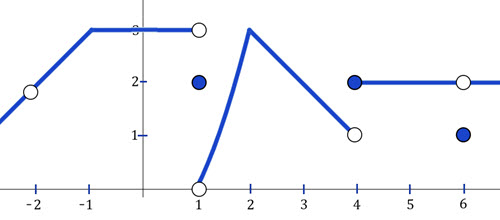Andymath.com features free videos, notes, and practice problems with answers! Printable pages make math easy. Are you ready to be a mathmagician?
Find the following infinite limits
\(\textbf{1)}\) \( \displaystyle \lim_{x\to 4^{-}} \frac{5}{x-4} \)
\(\textbf{2)}\) \( \displaystyle \lim_{x\to 4^{+}} \frac{5}{x-4} \)
\(\textbf{3)}\) \( \displaystyle \lim_{x\to -7^{+}} \frac{x+9}{x+7} \)
\(\textbf{4)}\)\( \displaystyle \lim_{x\to 5^{-}} \frac{e^x}{(x-5)^3} \)
\(\textbf{5)}\)\( \displaystyle \lim_{x\to 1^{-}} \frac{5}{x^3-1} \)
\(\textbf{6)}\)\( \displaystyle \lim_{x\to 1^{+}} \frac{5}{x^3-1} \)
\(\textbf{7)}\)\( \displaystyle \lim_{x\to 2^{+}} \frac{\ln(x)}{(x-2)^2} \)
\(\textbf{8)}\)\( \displaystyle \lim_{x\to -3^{-}} \frac{1}{x+3} \)
\(\textbf{9)}\)\( \displaystyle \lim_{x\to 4^{-}} \frac{\sqrt{x}}{x-4} \)
See Related Pages\(\)
\(\bullet\text{ Limit Calculator}\)
\(\,\,\,\,\,\,\,\,\text{(Symbolab.com)}\)
\(\bullet\text{ Calculus Homepage}\)
\(\,\,\,\,\,\,\,\,\text{All the Best Topics…}\)
\(\bullet\text{ Limits on Graphs}\)
\(\,\,\,\,\,\,\,\,\) \(…\)
\(…\)
\(\bullet\text{ Continuity on Graphs}\)
\(\,\,\,\,\,\,\,\,\) \(…\)
\(…\)
\(\bullet\text{ Piecewise Functions- Limits and Continuity}\)
\(\,\,\,\,\,\,\,\,\) \(…\)
\(…\)
\(\bullet\text{ Limits at Infinity}\)
\(\,\,\,\,\,\,\,\,\displaystyle\lim_{x\to \infty}\frac{5x^2+2x-10}{3x^2+4x-5}…\)
\(\bullet\text{ Trig Limits}\)
\(\,\,\,\,\,\,\,\,\displaystyle \lim_{\theta\to0} \frac{\sin \theta}{\theta}=1…\)
In Summary
In calculus, a limit is a value that a function approaches as the input of the function gets closer and closer to a particular value. Limits are used to understand the behavior of a function, and they are an important tool in understanding how functions behave in the real world.
One type of limit that can be encountered in calculus is an infinite limit. This occurs when the limit of a function as the input approaches a particular value is infinity.
For example, consider the function \(f(x) = 1/x\). As \(x\) gets closer and closer to 0, the value of \(f(x)\) gets larger and larger. In other words, the limit of \(f(x)\) as \(x\) approaches 0 is infinity. This can be written as:
\(\lim_{x \to 0} f(x) = \infty\)Another example of an infinite limit is the function g(x) = x^2. As x gets larger and larger, the value of g(x) also gets larger and larger. In other words, the limit of g(x) as x approaches infinity is also infinity. This can be written as:
\(\lim_{x \to \infty} g(x) = \infty\)Infinite limits can be difficult to work with, as they involve very large or very small values that may be difficult to visualize. However, they can be important in understanding the behavior of a function.
It’s also important to note that a function may have an infinite limit at a particular value, but not actually take on the value of infinity at that point. For example, the function \(f(x) = 1/x\) has an infinite limit as [late]x[/latex] approaches 0, but it never actually takes on the value of infinity at x=0. Instead, the function approaches infinity as x gets closer and closer to 0, but never actually reaches it.
Overall, infinite limits are a key concept in calculus that allow us to understand the behavior of functions as the input gets very large or very small. They can be difficult to work with, but they are an important tool in understanding how functions behave in the real world.
Infinite limits were first studied by the mathematician John Wallis in the 17th century. Wallis was able to rigorously define and prove the existence of infinite limits using techniques from calculus, which paved the way for future developments in the field.
About Andymath.com
Andymath.com is a free math website with the mission of helping students, teachers and tutors find helpful notes, useful sample problems with answers including step by step solutions, and other related materials to supplement classroom learning. If you have any requests for additional content, please contact Andy at tutoring@andymath.com. He will promptly add the content.
Topics cover Elementary Math, Middle School, Algebra, Geometry, Algebra 2/Pre-calculus/Trig, Calculus and Probability/Statistics. In the future, I hope to add Physics and Linear Algebra content.
Visit me on Youtube, Tiktok, Instagram and Facebook. Andymath content has a unique approach to presenting mathematics. The clear explanations, strong visuals mixed with dry humor regularly get millions of views. We are open to collaborations of all types, please contact Andy at tutoring@andymath.com for all enquiries. To offer financial support, visit my Patreon page. Let’s help students understand the math way of thinking!
Thank you for visiting. How exciting!